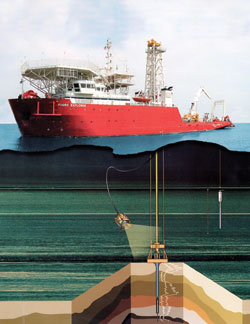What's new in exploration
Oil shows. The geophysical side of our business continues in the doldrums, epitomized in some recent society meetings this editor has attended. The June EAGE (Europe’s Geoscientists/Engineers) meeting, held in Stavanger, drew 3,215 people – about par for that show. The mood was upbeat except for one day when the sun came out and proved that sunlight and a giant rubber tent do not mix (temperatures inside were above 90°F, and people and equipment had to shut down). It helped that Stavanger – a great venue – was an oilfield town. Three weeks earlier, AAPG held its annual meeting in Salt Lake City, Utah, another great venue. But attendance there was only 4,700 – the lowest since 1987. While the show was a success in every other respect, the absence of oil-company delegates on the exhibit floor was glaring. Counting everything, there were about 900 technical presentations, and those that I attended or walked by seemed a little more sparse than usual, but nevertheless reasonably well attended. In a highly unscientific poll involving about a dozen exhibitors that I spoke with, all but one was disappointed. The common theme was: We pay a fortune to develop technologies for our oil company clients, then we pay even more to bring it to their attention, but there was too much “dead time” at this show; our cost per client was too high. Last fall, SEG was held in the same city and attendance was also down: they managed to get 5,700, the lowest in eight years. There is a litany of reasons as to why attendance is so depressed: SARS, terrorists, industry consolidation, and so on – and these are not wrong – but if it continues, a certain reality must be faced. So, expect the rumblings that I’ve heard to grow, namely, that some of these organizations need to merge. It is a natural consequence of the merger and acquisition activity among operators and vendors. SEG was at one time a division of AAPG, with their last joint meeting held in New York City in 1955. There is a spectrum of opinions on this topic, but one thing seems certain: exhibitor support will dwindle if these lackluster numbers persist. The seafloor business. The seafloor sampling business has undergone considerable change in the past decade. Because of the cost of deepwater exploration, any technology that can find an active hydrocarbon system and provide a means of assessing the regional distribution of hydrocarbons and source rock is worth considering on a cost/risk-reduction basis. Although reservoir geometry and possible horizons can be gleaned from seismic with increasing success, fluid composition remains extremely difficult to predict, pre-drill. AVO continues to make progress, but just when a company is sure that it knows what it’s doing, along comes a string of dry holes to re-establish humility and doubt. (For example, Kwanza basin offshore West Africa, while lying immediately south of several prolific Angolan Blocks, has seen a series of nine dry holes.) Fortunately, in most cases, reservoir seals leak, and the resulting seeps can be sampled using a coring (gravity or piston) tool. In addition, heat-flow surveys help establish thermal maturity and biodegradation risk. Except in a few cases, grid sampling is not done offshore as it is onshore. Instead, seeps are sought out for sampling. Seeps are found using 2D or 3D seismic, looking for structures that appear prone to leakage, or for a gas chimney, generally revealed as a vertical area of chaotic seismic signal. Sometimes, in addition to or in place of seismic, swath bathymetry, chirp sidescan sonar and/or sub-bottom profiling are used. New vessel. At the beginning of this year, Fugro launched a state-of-the-art vessel that can do almost anything on the seafloor. Modified from a new Western vessel that was a victim of capacity reduction, the unique ship can perform a wide range of geotechnical and exploration tasks. These include piezocone penetration tests, T-bar and in situ vane testing, a hydraulic-piston core sampling (downhole mode, continuous piston cores up to 33-ft lengths), a jumbo (over the stern) piston corer for up to 80-ft cores and ROV capability. Onboard equipment includes a 90-ft derrick with a 150-t capacity, two 35-t traction winches, a Dreco Top Drive, heave compensation, an automated pipe handling unit and 1,300 sq ft of laboratory.
Obviously, the vessel impressed this editor, but not as much as the faith required for investing in this sort of technology. The increased emphasis on seafloor hazards by governments and oil companies bodes well for this vessel. It is also a prime candidate for the type of consortia that often are needed to fund its work. Academics, geotechnical engineers, geochemists, etc., could all make good use of it, provided the multiple agendas can be worked out beforehand. It’s currently under contract, with a backlog of future work.
|
||||||||||||
- Quantum computing and subsurface prediction (January 2024)
- Machine learning-assisted induced seismicity characterization of the Ellenburger formation, Midland basin (August 2023)
- What's new in exploration (March 2023)
- Seismic and its contribution to the energy transition (January 2023)
- What's New in Exploration: Rocks can save or kill the planet (July 2022)
- Processing of a large offshore 3DVSP DAS survey in a producing well (June 2022)
- Applying ultra-deep LWD resistivity technology successfully in a SAGD operation (May 2019)
- Adoption of wireless intelligent completions advances (May 2019)
- Majors double down as takeaway crunch eases (April 2019)
- What’s new in well logging and formation evaluation (April 2019)
- Qualification of a 20,000-psi subsea BOP: A collaborative approach (February 2019)
- ConocoPhillips’ Greg Leveille sees rapid trajectory of technical advancement continuing (February 2019)





